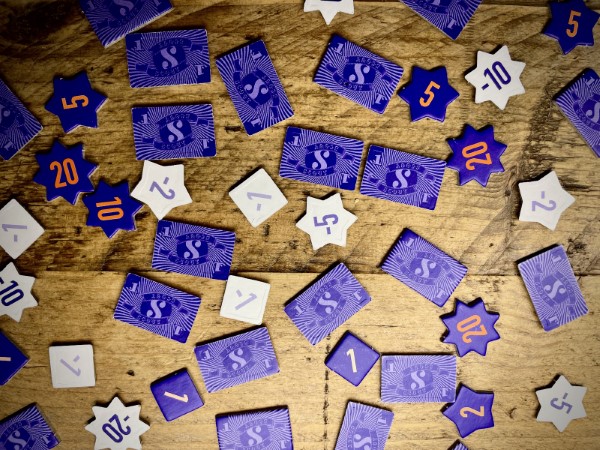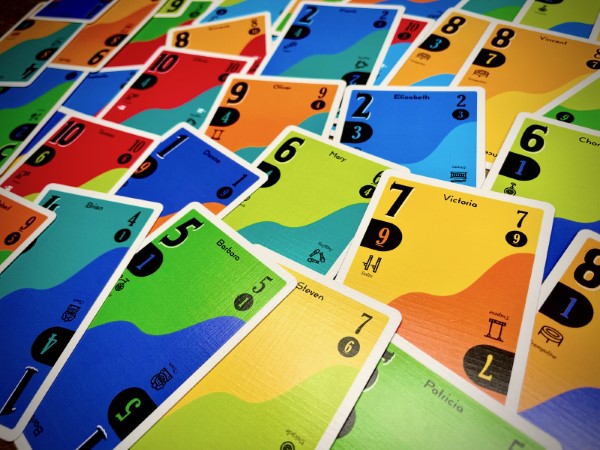Scout: A Card Game Where Your Circus Takes the Stage

In the card game Scout, your circus arrives in town, and you put your finest performers on stage to deliver a magnificent show. However, competition is fierce, and your opponents may even steal your performers to enrich their shows. Ensure your performance is dazzling and outsmart all your competitors to become the most prestigious circus in town.
Scout is, at its core, a ladder-climbing game with a distinct twist: players cannot rearrange their cards, which have two different values, according to their orientation. When you receive your cards at the beginning of a round, you cannot change their order but choose your preferred orientation. From then on, you will either perform a circus show or recruit (Scout) members from the last show performed. Scout is more straightforward than it seems, easy to learn, quick, and fast-paced, while also being deep in tactics, engaging, and challenging.
Scout is recommended for 1-5 players, ideally played with three or more, and is suitable for ages nine and above. A game can last from a handful of minutes to longer sessions depending on the number of players.

Gameplay — From Scout to Show
The game objective is to score points by collecting a score pile when disposing of sets of cards from your hand. A set can have one card, multiple matching cards, or multiple consecutive cards (in ascending or descending order). In each turn, players will either "Show" a set of cards or "Scout" (i.e., recruit) new cards to strengthen their hands. However, players can't rearrange their cards and can only choose the orientation of the cards in their hands at the beginning of each round. Cards have different values for each orientation.
During setup, each player is given a “Scout and Show” token. A first player is chosen and takes the first player marker. The first player can be the one who owns the "one or two" card. After the owner of the first player marker shuffles the cards, each player is dealt a number of cards (depending on player count). Players can't rearrange cards but must choose their orientation.
During their turn, players can do one of three things. They can Show a set of cards, Scout for a card from the active set, Scout and Show once per round, or do both. To Show cards, they must form a set. If an active set is already on the table, the player's set must be more powerful than the active one. A set with more cards is more powerful. If sets are of equal size, a matching set is more powerful than a consecutive set. A set of cards of equal size and type (matching or consecutive) with higher values is also more powerful. As long as the player can Show, they collect the active set cards in their score pile, play their set of cards, and become the owner of the new active set.
Alternatively, players can Scout cards for their hand. They take one card from the extremities of the active set and add it to their hand in any position and orientation. The active set owner takes a Scout token worth a point at the end of the round. Players can also choose to Scout and Show in the same turn by flipping their Scout and Show token; remember to flip it upwards at the beginning of the following round.
At the end of each round, points are scored based on the number of cards in the scoring pile. In addition, Scout tokens are worth one point, and the remaining cards in your hand are worth negative points. The player who triggered the end of the round doesn't take negative points. The first player token moves clockwise. The game ends after as many rounds as there are players. The player with the highest score wins.

Review — Where Traditional Mechanics Meet Novel Gameplay
Scout's core gameplay feels fresh and unique, mixing traditional and novel mechanics. Well-known mechanics include playing sets of matching cards and sequences (runs) in ascending or descending order. It also adopts its flavor of familiar card game mechanics like hand management, ladder climbing, and trick-taking. However, the game imposes a number of restrictions on gameplay. You are constrained to keep your hand cards in the order you acquired them, but you can choose their hand orientation at the beginning of a round. Cards chosen to be played must be brought to play in the same order they appear in your hand. These constraints add a layer of structure and challenge to gameplay, requiring you to think outside the box. Finally, you can Scout cards from the active set and place them anywhere in your hand, in any orientation, further improving your hand management tactics. Scouting may help eliminate unwanted cards and shape your hand to optimize future Shows. The combination of traditional mechanics, gameplay constraints, and Scouting makes Scout stand out in the ladder-climbing card game genre.
The game's designed uncertainty plays a crucial role in gameplay. The game relies heavily on the randomness of dealing cards and on push-your-luck during game rounds. Starting a round with a "terrible hand" can be frustrating. Yet, clever Scouting and hand management can help you turn the odds in your favor. Performance contingency and player agency can be limited, though; sometimes, the cards at your hand are a genuine hindrance leading to a frustrating round. Fortunately, this is only sometimes the case, and the game has enough player agency to provide room for strategic planning and play. Overall, the game's stochastic contingency is more beneficial than being a liability and contributes to its high replayability, as no round is ever the same.
The artwork is stunning but modern and abstract. Yet, it needs to convey the theme of the game. Simply put, this is an abstract game with the circus theme being secondary, serving merely as a backdrop. As is typical of abstract games, fictional involvement is weak. A positive aspect is that the Scout and Show mechanics subtly and indirectly express the circus theme. Please note that our remarks about the weak representation of the game's theme are not meant as a criticism. A light background theme is usually expected from the abstract game genre and has no negative impact on gameplay. Meanwhile, the outstanding artwork makes up for theme-related shortcomings with cards cleverly designed to be easily understood, intuitive, and functional.
Player interaction is spot on, encouraging deduction and guessing of other players' plans and strategies. There are plenty of ways to outsmart your opponents, and you will have a significant advantage overall if you have superior deduction skills. For example, showing a set that you believe is unbeatable may force players to Scout, rewarding you with Scout tokens.
Complexity, setup, teardown, and downtime are minimal, making it an ideal filler and gateway game. If you're a newcomer to board gaming, Scout is an excellent game to start with. However, the game offers enough depth to appeal to challenge seekers. Scout boasts great replayability and may entertain you and your friends for hours.

Final Thoughts
Scout is a "light abstract strategy game with deep strategy"; it's easy to learn and challenging to master, and it's quick and fast-paced. The game's straightforward but rich mechanics make it charming and engaging. It's no small feat that it received the 2022 Spiel des Jahres Nominee award and is extremely popular. It caters to a broad audience, from kids to board game enthusiasts. And as people say, "The circus leaves a sweet memory."
Pros:
- Delivers innovative and fresh core gameplay that mixes traditional and novel mechanics.
- Engaging, challenging, and deep in tactics.
- Quick and fast-paced.
Cons:
- The game relies heavily on randomness, which can be frustrating at times.
- The game may not be suitable for players who prefer complex gameplay mechanics.
- The game may need more replayability value for expert players.
Disclosure: we received a complimentary review copy of this game.
Note: This article is provided by Roll & Mind.






